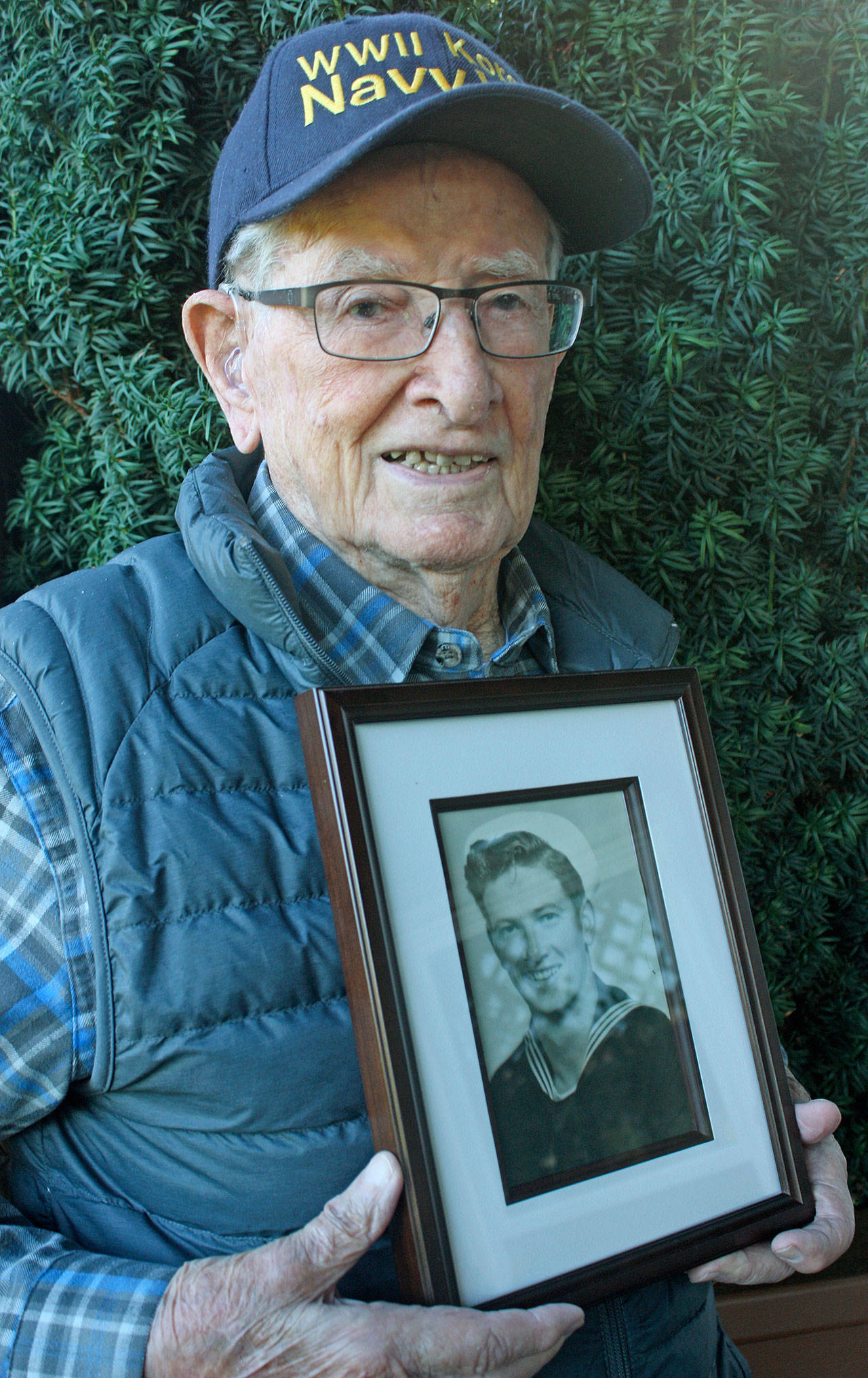When he was a young man. Robert “Mike” Lisle helped guide American ships through the hostile waters of World War II’s Pacific theater.
Trained by his nation to scout out approaching trouble, be it enemy mine or disruptive storm, he served on a U.S. Navy minesweeper, weather ship and safety patrol boat.
“It was good duty, but it also was monotonous,” said the soft-spoken, 96-year-old Auburn man, sitting quietly in the tidy home he shares with his second wife, Virginia, to whom he has been married for more than 40 years. “It was monotonous duty, yet it was extremely important to let everybody know what was coming up.”
Lisle served honorably in the Navy as a quartermaster – a naval petty officer responsible for steering and signals – during WWII, and later, as a re-enlisted man aboard the destroyer USS Rooks, which escorted and plane-guarded the Navy’s main striking force off the Korean Peninsula during the Korean War.
Mike was one of three Lisle brothers who served during that period, Chuck with the Navy Seabees, and Jim with the Army Tank Corps in Europe, where he earned the Bronze Star.
Having served his country, Mike Lisle came home, raised a family and enjoyed the good life.
To keep touch with his military past and its community, some 15 years ago, he joined Auburn VFW Post 1741. He has lived in Auburn for about 50 years.
A cancer survivor, Lisle struggles with mobility and diminishing eyesight, but his humor is as sharp as ever, and he appreciates each day as it comes.
On this weekend, when the country honors its veterans past and present, Lisle is eternally grateful for the opportunity his nation gave him to serve.
“I’m glad I was able to do something,” Lisle said.
Added Roger Flygare, VFW Post 1741 commander: “There isn’t a finer gentleman to be recognized for his service to our country.”
Humble beginnings
Lisle was born in 1923 on a farm near King Hill, a hamlet in mostly agrarian south central Idaho.
As the family farm was too remote for any immediate doctor visits, when the time for Lisle to be born, circumstances forced his sister into the role of emergency midwife. Undaunted, she carefully brought the boy into the world, one of 10 children in the family.
Lisle has since kidded his sister for being the one who “gave me my first spanking.”
The family followed the father to wherever he could find work in construction. They moved to Redmond, Ore., in a horse and buggy. They eventually moved to Hilmar, a town in California’s central valley, where Lisle began but did not finish high school.
“Being a smart-ass teenager, who needs that anyway?” Lisle said of his academics. “It was one of the biggest mistakes I ever made. … Like a typical teenager, I didn’t know what to do.”
In 1963, Lisle would earn his GED.
After working in a mill in Naches for a couple of months, the brash, 18-year-old kid enlisted in the Navy in 1942. Soon, he got a taste of a different part of the world.
Sent to the Bremerton Naval Yard, Lisle was assigned to the USS YMS (yard minesweeper)-289, out of San Diego, and poised for Pacific waters. The minesweeper, equipped with anti-submarine gear but without radar, played a significant role in keeping waterways clear for safe shipping.
Lisle and his crew – assigned to the Hawaiian Sea Frontier – swept clear the channels out of Pearl Harbor, Midway and other islands, ports and harbors. A routine run began at 3 a.m., with a channel sweep extending to about 10 miles.
“Every ship had to follow a channel we set up and swept every day,” Lisle explained.
While escorting a tanker off Midway Island one day, the crew came upon a mine.
“We were not sure at the time whether it was an American or a Japanese mine … nobody seems to know,” Lisle said. “We actually cut (it) loose from the tanker and it surfaced. … (Our) mine sweeper had two cutters to cut the mine loose from its anchors.”
It was dangerous, tedious duty.
“It wasn’t tough service as far as what we were doing, but it was monotonous,” Lisle insisted, “and I think a lot of guys were looking forward to liberty when we got back in port.
“You stayed busy enough not to spend time thinking about it,” he said of the work. “It was interesting. I enjoyed it. But, of course, there were times you thought about, ‘geez, I’ll be glad when I get out of this mess.’ But, on the other hand, I never got into any kind of trouble as far as the ship was concerned.”
Later, the Navy assigned Lisle to the USS PCE (Patrol Craft Escort)-884, a weather ship that tracked and monitored conditions and delivered forecasts for the U.S. fleet.
Lisle recalls one uncomfortable episode when the skipper ordered the crew to get out of the path of a looming typhoon. With one of the ships two engines down, Lisle just managed to steer the ship away from harm.
Back home
After his service, Lisle was a collision repairman for shops and claims adjuster for insurance companies Allstate and Pemco.
In full retirement today, the Lisles travel and enjoy time with family and friends.
It’s been a fulfilling ride.
“I have never regretted serving in the Navy. In fact, I’m proud to have served my country, even though I was disappointed that I never got to take part in the real efforts that took place in the fight for supremacy in the Pacific Ocean over Japan,” Lisle said. “On the other hand, if I had, I might not be (here) today.
“A lot of good things happened, lot of good, lot of bad,” Lisle said. “Life goes on, no matter what.”


